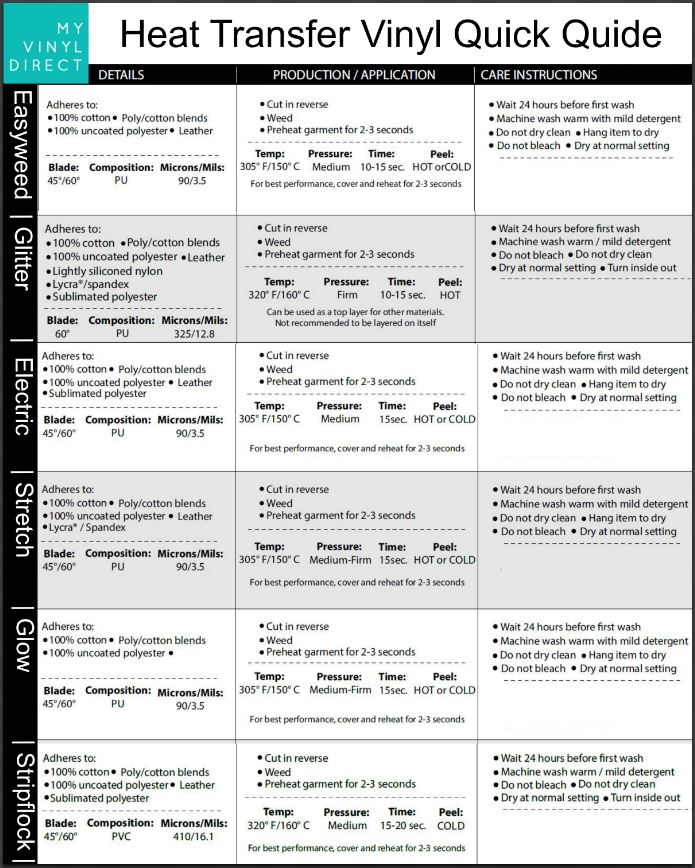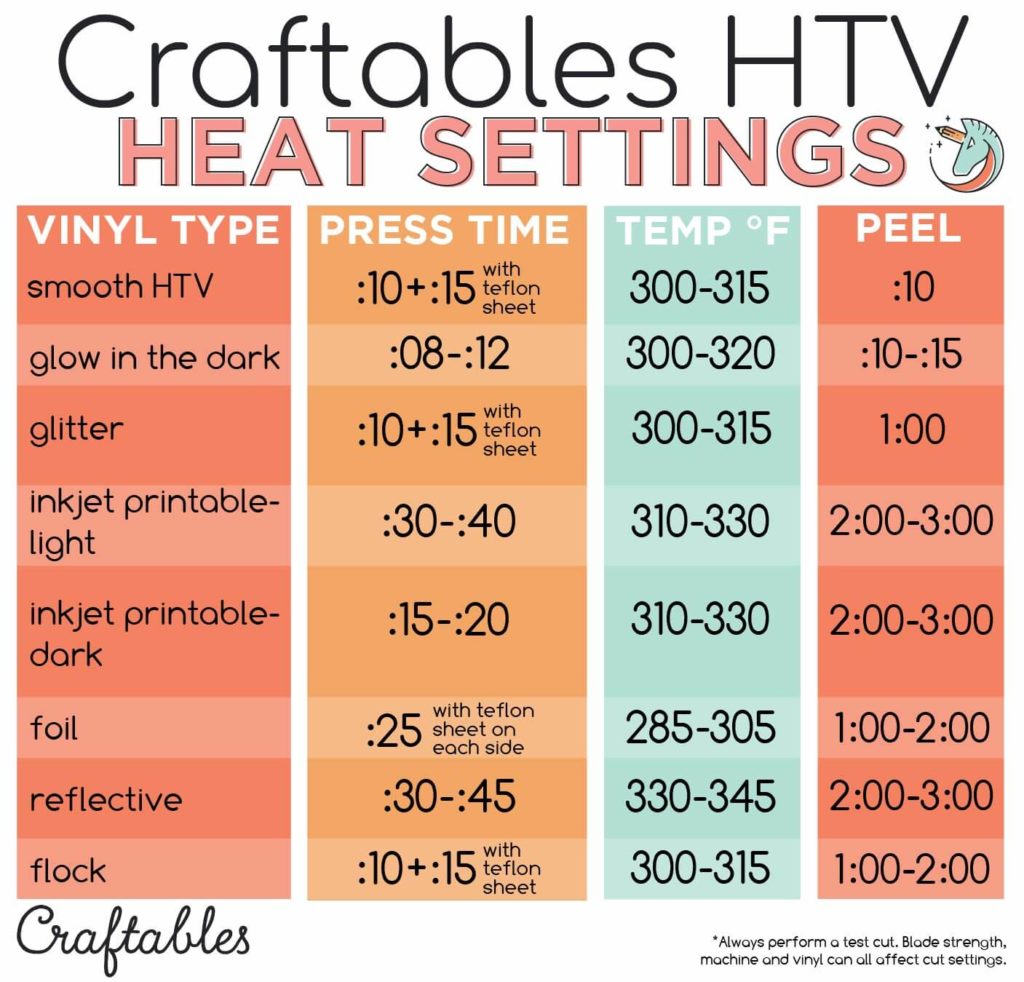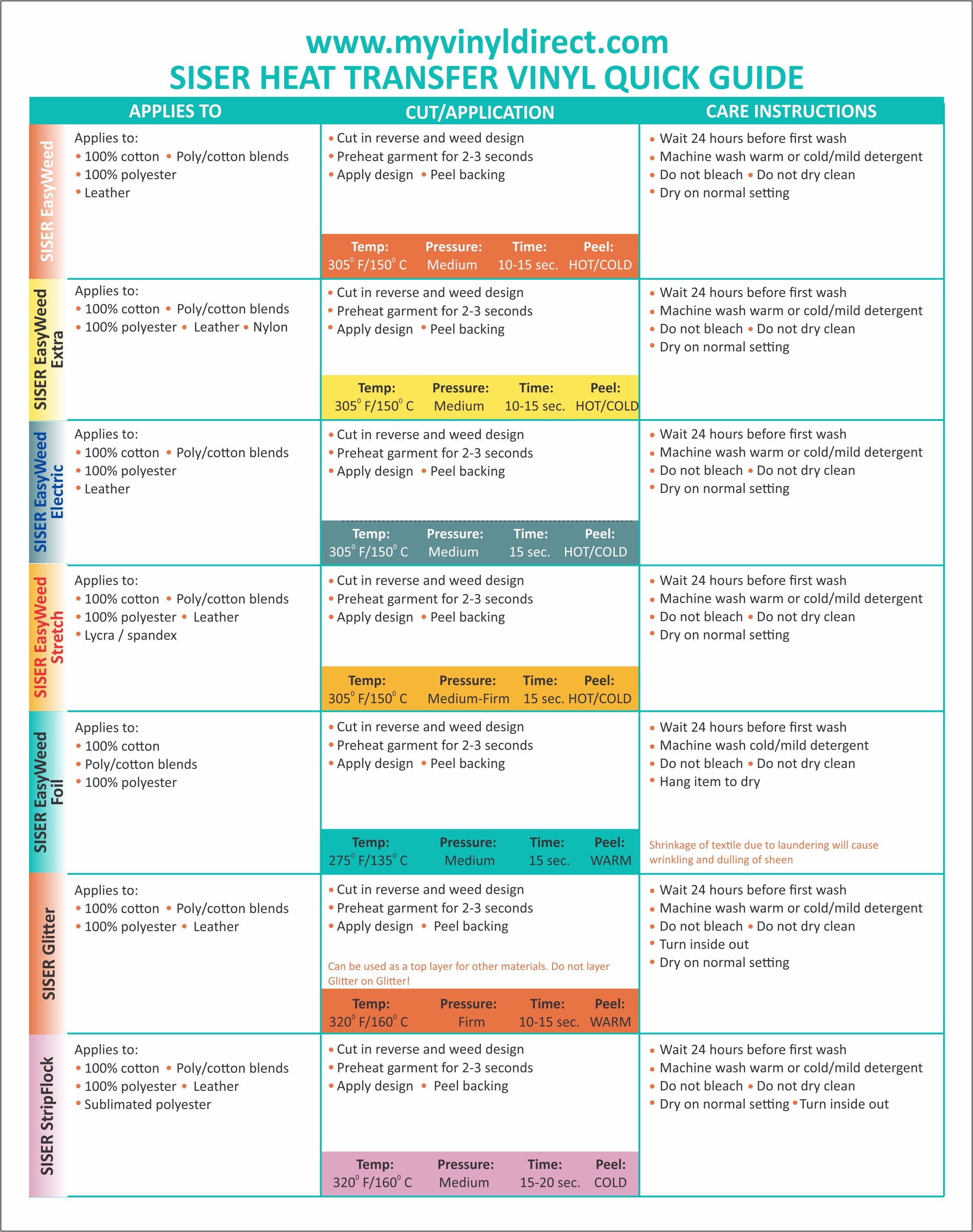
Pin by Noemi Virostek on Cricut Cricut heat transfer vinyl
Heat-Transfer Material. Base Material. Apply. Need extra help? Read our step-by-step tutorials Learn More About Cricut. Actual delivery date may vary depending on origin, destination, time, and other conditions. Some restrictions apply. *To qualify for "get $20 when you spend $100" promotion, customer must complete a transaction with a.

Free Vinyl Craft Resources Sizing Chart, Heat Settings & More
305°-315° F. 10-15 seconds. cold peel. Embossed. 305°-310° F. 10 seconds. cold peel. These heat transfer vinyl settings are for the Cricut heat presses, but there are some other heat presses that work for making projects with this material. Consecuently, use this summary table with the settings as a guide, because remember that each heat.

Heat Press Temperature Guide
Updated: Nov. 2, 2023. We have created at-a-glance time and temperature charts for Siser heat transfer vinyl (HTV) used with either a conventional heat press or a Cricut EasyPress.There is a chart for each heat press type available for download. Our single-page full-color printable charts include all current varieties of HTV produced by Siser North America. Our charts provide time, temperature.

Heat Transfer Vinyl Guide Heat Transfer Vinyl Temperature Guide
Achieving the optimal temperature is vital for obtaining vibrant, durable, and professional-looking results in heat pressing applications. The correct temperature ensures that the materials being pressed, such as transfer paper or vinyl, reach the required level of heat for effective bonding with the substrate.

Printable Heat Transfer Vinyl Temperature And Time Printable Word
Weed the excess material. After everything has been set up, apply the glitter vinyl to the apparel with medium pressure, using a heat range between 300 and 320 degrees for 15 to 20 seconds. After the carrier paper has been peeled, wash the transfer after 24 hours.

heat press time temperature chart everything you should high quality
Monday, November 14, 2022 If you're like me and you have trouble remembering temperature and time for HTV vinyl, I have just the craft hack for you! You can download these free printable HTV time and temperature cheat sheets from So Fontsy for easy reference so you're never left searching for the right time and temp again!

Pin on ScanNcut
The ideals temperature for heat transfer vinyl belongs in 260°F for 315°F (130°C to 160°C), using moderate pressure. It is very important to read the product description of the heat-pressed product before deed any work.. The best time to pressed heat transfer vinyl with medium pressure has 8 to 15 seconds. Majority heat presses have an.
Heat Transfer Vinyl Temperature and Time Settings (at Your Fingertips
The type of fabric will determine the temperature needed to make a permanent transfer. 100 percent cotton requires the highest temperature, which is around 380 degrees Fahrenheit. Polyester responds to a more delicate 270, so be careful with it! Many types of fabrics take well to the heat transfer between 315 and 350, but if you're not sure.
Heat Transfer Vinyl Temperature and Time Settings (at Your Fingertips
HEAT TRANSFER VINYL.. HEAT APPLICATION SETTINGS: Temperature: 305°F/150°C Pressure: Medium; Press Time: 10-15 seconds *Preheat all fabric prior to pressing for best results!*. Every type of Heat Transfer Vinyl has its own recommended press time, temperature, and pressure settings (see above 'Heat Application Settings"), but make sure to.

Sublimation Heat Press Settings Quick Reference Guide USCutter
What temperature do I use for heat transfer vinyl? Material-Specific Settings: Different materials necessitate distinct settings.Basic Cotton Fabric, aim for 305°F(151°C) for 10-15 seconds. Sublimated polyester needs just 270°F(132°C) for 15 seconds, stretch materials require 305°F (151°C) and a pressing time of 15 seconds, and glitter vinyl is best at 320°F (160°C) and a pressing time.

Problems Getting Heat Transfer Vinyl To Adhere? Try These Tricks
$11.99 Add To Cart Glitter Glow in the Dark Heat Transfer Vinyl $14.99 Add To Cart Remember that heat transfer product come in different patterns and textures. Some are thicker, some are thinner, that's why their heat/temperature and time settings differ. Pin this cheat sheet, print it out, and place it somewhere in your work area.

[Infographic] Heat Press Temperature Chart for HTV Snip to It
What is HTV, and how do I determine the correct time and temperature for it? HTV stands for heat transfer vinyl or iron-on. The time and temperature for HTV can vary by brand and the material you're pressing it onto. It's best to check the manufacturer's website or product listing for specific instructions.

Heat Press Temperature Guide Vinyl Yoiki Guide
Setting the time The timer is usually set in much the same way as the temperature. This too can be set exactly, and if you get the right sort of heat press, it will turn off or open the lid when the time has elapsed. Others will make a noise to let you know that your transfer is now ready. Time and temperature guide
Heat Transfer Vinyl Temperature and Time Settings (at Your Fingertips
• Cover design with Heat Transfer Cover Sheet or Multipurpose Paper. • Place on flat, hard surface (ironing board not recommended). • Press iron with medium/firm pressure for 10-15 seconds. • Peel carrier hot or cold. Application Instructions (Heat Press): • Preheat garment for 2-3 seconds. • Apply design at 305°F / 150°C

heat press temperature chart cricut best picture of chart
Every heat transfer vinyl is a little different in regards to pressing time, temperature, pressure, and peel! In this blog, we go over some characteristics of our most popular htv and show temperature and time recommendations with a handy chart. Heat Press Time & Temp Chart Hot vs Cold Peel Hot Peel

Printable Sublimation Color Chart
Setting Temperature How to set temperature time pressure for heat press machine? It's like setting the time. The only difference is that the dial has a Celsius or Fahrenheit sign. It's almost like using a microwave or oven. The quality and clarity of the transfer depends on some factors. These factors are time, pressure and temperature.